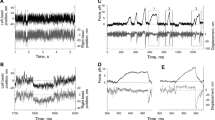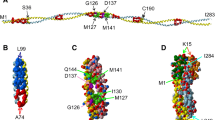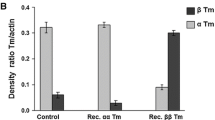Summary
-
1.
Artificial actomyosin (reconstituted from its isolated components myosin and actin without natural tropomyosin) takes up ∼3 μmoles calcium/g actomyosin if one increases the concentration of free Ca++ ions from ∼10−9 M to 10−6 M.
-
2.
In the presence of magnesium, however, no calcium is taken up by artificial actomyosin.
-
3.
The results 1. and 2. are independent of the actin content of actomyosin; accordingly, they hold true for pure myosin too.
-
4.
Natural tropomyosin increases the calcium content of actomyosin independent of the free Ca++ at a constant amount; the concentration dependent increment remains in the same order as without tropomyosin.
-
5.
In the presence of natural tropomyosin the calcium increment is independent of the magnesium concentration. Magnesium, however, decreases the total amount of bound calcium at all concentrations of free Ca++.
-
6.
Bound calcium and bound magnesium are negatively correlated: The sum of bound calcium plus magnesium is 8 μmoles/g actomyosin.
-
7.
Consequence: it is myosin that binds the calcium that regulates muscular activity.
Similar content being viewed by others
References
Barany, M., Finkelman, F., Therattil-Antony, T.: Studies on the bound calcium of actin. Arch. Biochem.98, 28–45 (1962).
Dancker, P.: Natural tropomyosin as a physiological inhibitor of the contractile activity of actomyosin. Pflügers Arch.315, 187–197 (1970).
Drabikowski, W., Barylko, B., Drabowska, R., Nowak, E.: Binding of calcium by troponin. Bull. Acad. pol. Sci.16, 397–400 (1968).
Ebashi, S., Ebashi, F., Kodama, A.: Troponin as the Ca++-receptive protein in the contractile system. J. Biochem. (Tokyo)62, 137–138 (1967).
—, Endo, M.: Calcium ion and muscle contraction. Progr. Biophys.18, 123–183 (1968).
—, Kodama, S. A., Ebashi, F.: Troponin. I. Preparation and physiological function. J. Biochem. (Tokyo)64, 465–477 (1968).
Fuchs, F., Briggs, F. N.: The site of calcium binding in relation to the activation of myofibrillar contraction. J. gen. Physiol.51, 655–676 (1968).
Hasselbach, W.: Die Bindung von Adenosindiphosphat, von anorganischem Phosphat und von Erdalkalien an die Strukturproteine des Muskels. Biochim. biophys. Acta (Amst.)25, 562–574 (1957).
Nanninga, L. B.: Calculation of free magnesium calcium and potassium in muscle. Biochim. biophys. Acta (Amst.)54, 338–344 (1961).
Parker, C. J. Jr., Gergely, J.: The role of Ca in the adenosine triphosphatase activity of myofibrils and in the mechanics of the relaxing factor system of muscle. J. biol. Chem.236, 411–415 (1962).
Weber, A., Herz, R.: The binding of calcium to actomyosin systems in relation to their biological activity. J. biol. Chem.238, 599–605 (1963).
Author information
Authors and Affiliations
Rights and permissions
About this article
Cite this article
Dancker, P. The binding of calcium and magnesium to actomyosin and its modification by natural troposmyosin. Pflugers Arch. 315, 198–211 (1970). https://doi.org/10.1007/BF00586413
Received:
Issue Date:
DOI: https://doi.org/10.1007/BF00586413




